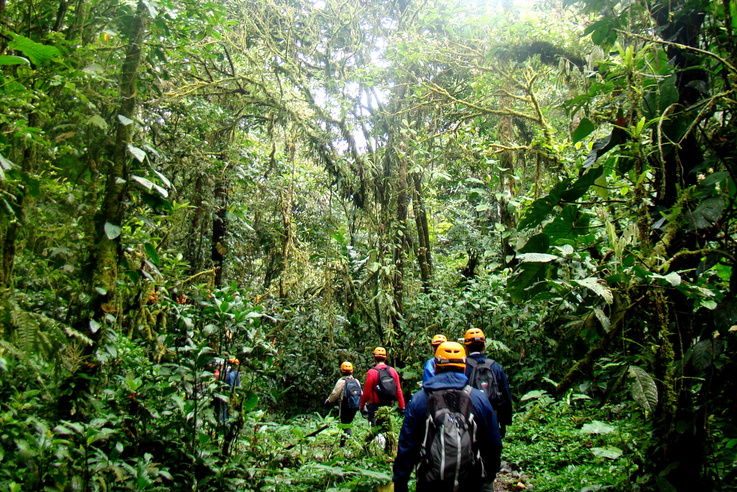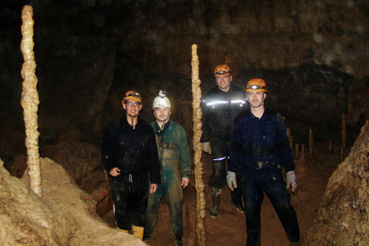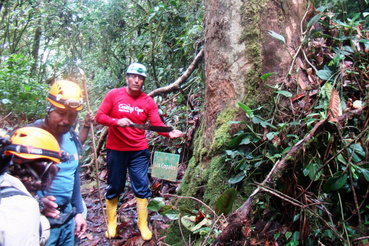Researchers crawling in guano reveal the Earth's climate past to find out what the future holds
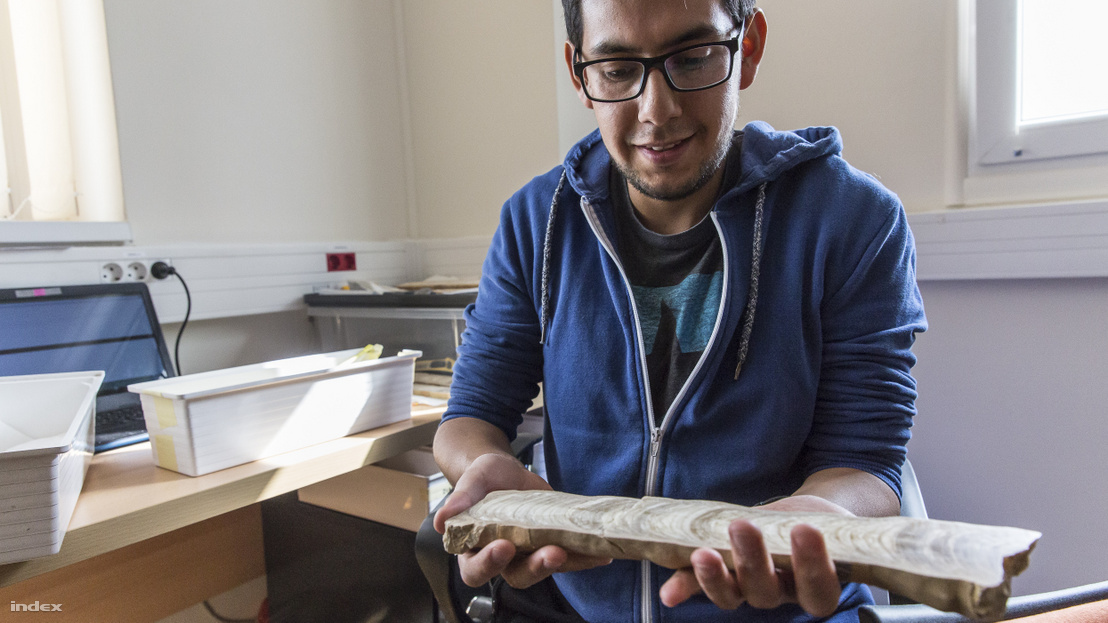
If you have ever been to a limestone cave, you were most likely amazed by the calcium carbonate (calcite, aragonite) formations that tend to excite human imagination. Many have wondered about the secrets enclosed in these columns that grew into a plethora of colours and shapes thanks to individual drops of precipitation over the course of several millennia. But apart from the Nuclear Research Institute of the Hungarian Academy of Sciences (Atomki), few would have thought that dripstones have so much to do with the trees of the Amazon rainforest and with the digestion of bats. The researchers of Atomki, an institute founded in 1954, have recently embarked upon an expedition to Ecuador to collect dripstones, growth ring samples, and even some guano that could be useful for their paleoclimatic reconstructions.
Covering Climate Now
This article is published as a part of Index's partnership with Covering Climate Now, a global collaboration of more than 250 news outlets to strengthen coverage of the climate story. The English edition of Index regularly covers the most relevant stories of Hungary. If you would like to know more, visit our website, or follow us on Twitter and Facebook.
But what is a paleoclimatic reconstruction?
During paleoclimatic reconstruction, researchers determine certain attributes of ancient climatic conditions, mostly corresponding to temperatures, precipitation, and vegetation, and make assessments about how and why these parameters of the climate have changed over a given time period. They examine geological imprints with precisely definable ages and based on the physical, chemical, and biological attributes of the ancient material, they assess the climatic conditions of the period and the causal relationships of climate changes in the era. Paleoclimatologists usually study the polar ice caps, glaciers, the sediments of oceans, seas, and lakes, or, like researchers of Atomki, limestones.
But paleoclimatology is not merely the descriptive study of our planet's climate past, its findings are not relegated to the footnotes, they are not only lexical knowledge collected in history books, instead, this data plays an active role in shaping our future. By learning about the causes of ancient changes in our climate, researchers acquire a tool for producing more accurate estimates about what lies in the future, but more on that later. First, let's see why Hungarian researchers had to travel to Ecuador instead of exploring the Aggtelek Karst right within their country' borders.
"Biodiversity in Ecuador is amongst the highest in the world, as the four main areas of the country - Amazonia, the Andes, the coastline, and the Galápagos Islands - have completely different climates and geological conditions. Life there is extremely sensitive to sudden changes in climate. As up until recent times, regular instrumental data was not collected in the country, we know very little about the past. Compared to other, well-researched areas such as Europe or North America, there was not much paleoclimatological research done in South America," László Palcsuk, the leader of the project explained to Index.
Dripstones tell a tale
Let's get to the juicy part right away: maybe the least enjoyable part of the researchers' job was collecting samples of faecal matter. Scientists in the caves around Pastaza were crawling around on all fours taking samples of bat guano, as checking the pteropine excrement for plant seeds allows scientists to draw conclusions about plant diversity of the area, and even the distribution of different bat species can be mapped out using the DNA found in the organic matter contained in the guano.
But, without underestimating the significance of guano-based findings, let's move on to the really important samples of this expedition: the tree growth rings and the dripstones. As László Palcsu said:
"We are always looking for some kind of geological imprint, and from them, we draw conclusions about the climate of the past. The calcium carbonate formations, primarily the stalagmites which rise from the ground up, are especially useful for this purpose as the carbonate layers collecting on top of each other form an orderly timeline."
The samples collected in the limestone caves of Ecuador were brought back to Debrecen, Hungary. There, using water beam dissection, researchers have cut the samples in half along their lengths and created thin, translucent cross-sections of their centres, from which they took a large number of samples less than a millimetre apart from each other. "We examine the thickness and the structure of these carbonate layers, the trace elements found within them, then we measure the stable isotope ratios of oxygen and carbon, and using uranium-series dating (230Th/234U), we determine the date of formation. The study of dripstones allows us to examine the climatic conditions of the last couple of hundreds of millennia."
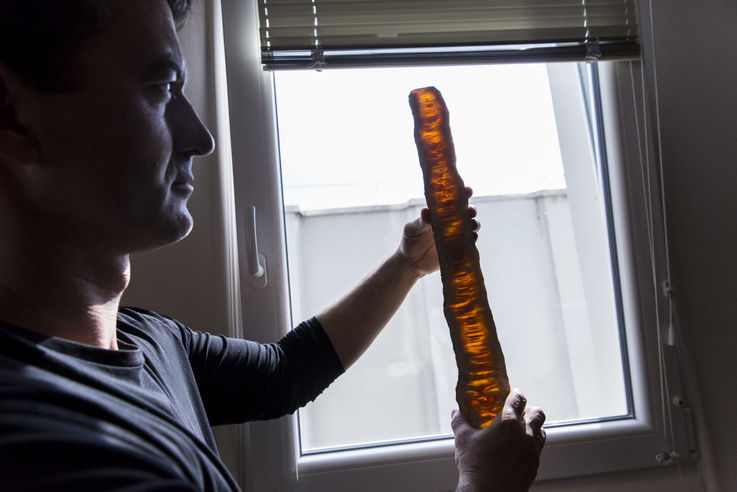

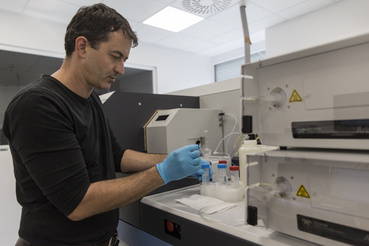
The carbonate layers are mostly made of calcite (calcium carbonate), researchers are trying to measure the carbon and oxygen isotope composition ( the ratios of 3C/ 12C and 18O/ 16O isotopes) at the smallest possible sample size. Isotopes of carbon contain information about the plants on the surface above the cave, while the concentration of oxygen isotopes offers a clue about the temperatures, the amounts of precipitation, and the origins of the rainwater falling in the area.
This last one might sound a bit incredible: Can we really tell the origin of the rain that had washed into the ground and contributed to the formation of dripstones thousands of years ago? How? In a nutshell, it was established that the karst area in question had always received precipitation from the East, from the Amazon basin, as to the West, the Andes function as a wall blocking air currents coming from the Pacific Ocean. The Amazon River's surroundings are divided into several areas, and all of these areas have a predominant isotope composition. If the isotope ratio changes from one sample to the next, researchers can start investigating what could have caused that change.
The dripstones are accurately dated by the quantity of small traces of uranium isotopes and their derivatives that can be found in the carbonate: researchers are going to measure the amount of Uranium 234 and Thorium 230 isotopes, thus bringing the uncertainty of the age determination down to just a couple of decades in case of a twenty-thousand-year-old dripstone layer. This dating process and the data acquired from the samples form the basis of paleoclimatic reconstruction.
You have to study the trees
The temporal scope is much smaller when scientists are studying the growth rings of trees: these examinations lead to a better understanding of the changes in our climate in the past couple of decades by comparing the data acquired from the samples to the existing weather records of the period. "Beyond the dendrochronology and the radiocarbon dating, we would like to draw conclusions about the attributes, origins, amounts, and temperatures of the precipitation in the last couple of decades," László Palcsu said.
Researchers have taken more than 60 samples from the following tree species: Mimosaceae (Inga sps.), Lauraceae (Nectandra sp.), Meliaceae (Cedrela odorata sp.), and Fabaceae (Caesalpiniaceae Tachigalia sp.). Many of these tree-ring samples have already gone through the sanding process, therefore their structure can already be seen under a microscope. However, what is interesting in the dendrochronology is that a few species aside, tropical trees do not really tend to grow visible rings, therefore the samples are usually dated with radiocarbon technology instead of ring-counting.
What still interests scientists in these samples is primarily the composition of oxygen isotopes within the alpha-cellulose of the wood. Knowing this allows them to determine the changes in the origins of precipitation in the area. But why are there no growth rings in tropical trees?
"The climate gets more stable as you approach the equator, there are no changes of seasons as there is in temperate climates, therefore that change cannot be reflected by the development of the trees' material. Some species are exceptions, but those are mostly non-indigenous species with rings reflecting the changes of the dry and wet seasons,"
as Danny Vargas explained to us. Vargas is an alumnus of the Salesian Polytechnic University of Quito who is doing his doctorate and research in Hungary at the University of Debrecen and at the Isotope Climatology and Environmental Research Centre (ICER) of Atomki. Vargas played an important role in the expedition: he scouted the known caves of the few karst regions of Ecuador (including the Mera region where the study was eventually conducted), looking for caves where the Debrecen-based team could find dripstones suitable for the study.
After all of this, it's not unreasonable to ask why we need these samples of dripstones and tree-rings, and if this paleoclimatic reconstruction is, in general, useful for us in any way or not. But what's at stake here is the accuracy of the predictions we make about our future. When climate researchers are assessing the possible long- and short-term effects and consequences of climate change, they are running models based on the available data. The merits of these models can most accurately be evaluated by running them on data from the past, the outcomes of which are already known. A climate change model is only as good as accurately it reconstructs past climatic events.
The tree samples cover a short period of time, only a couple of decades, while the dripstones contain information from 0 to as far back as 600,000 years ago - and this means that there is a period when the dripstone and tree samples overlap, which makes them comparable to each other and to the existing weather records, making the obtainable climatic information even more accurate. (By the way, there was a strange side effect to nuclear testing that started sixty years ago. Radioactive isotopes that were never present in the air or in water can only be found from the samples dating after the first atmospheric nuclear tests sixty years ago, and their presence certainly helps in more accurate dating of the samples.)
International team in the caves of Ecuador
The expedition was conducted in the caves near the town of Pastaza in the southeastern part of the Mera karst region at the beginning of February 2019. Two researchers from the Salesian University, physicist Sheila Serrano and biologist Marco Cerna, and two of their students, Madison Herrera and Lisseth Carlosama participated in the expedition, while on behalf of Atomki, project manager and physicist László Palcsu, karst researcher Marjan Temovski, meteorologist Elemér László, and PhD student Danny Vargas were on the team. Researchers collected approximately ten stalagmites from four caves. One of these was found broken, the rest were removed by the researchers with permission from the authorities of Ecuador. The scientists also installed temperature sensors and precipitation gauges in and around the caves and took tree core samples from surrounding trees.
"We approached the caves by car, and then we had to walk for around an hour, oftentimes ankle-deep in the mud. The rainforest bustles with plant life, but we did not see many animals as they are said to come out in the open around four in the afternoon, but our local guide advised against waiting for them. Luckily we avoided the rain. The weather was not that hot, but it was humid, which caused us to sweat a lot in our long-sleeved clothes we were wearing to protect ourselves from mosquitoes," László Palcsu reminisced about the expedition, and continued:
"Finding the caves and looking for dripstones was a great feeling. Once we were crawling around in the caves with water up to our necks, then another time, at the karsts near the coasts, we had hundreds of bats whizzing past our ears, while we were examining dripstones in guano-covered caves. That was a unique experience as well, luckily, none of us are afraid of bats."

Support the independent media!
The English section of Index is financed from donations.


